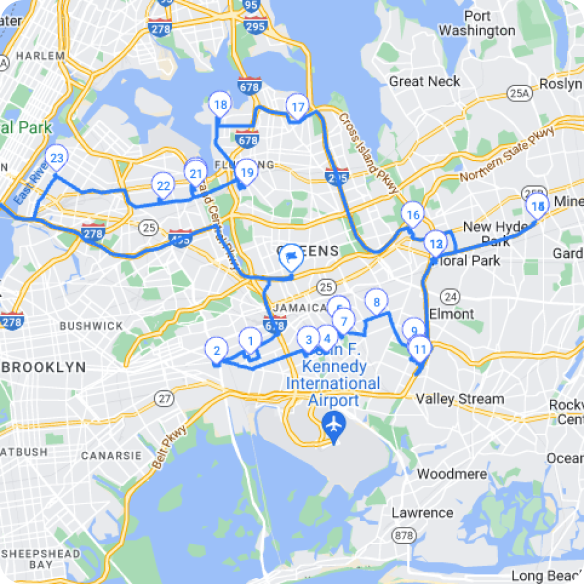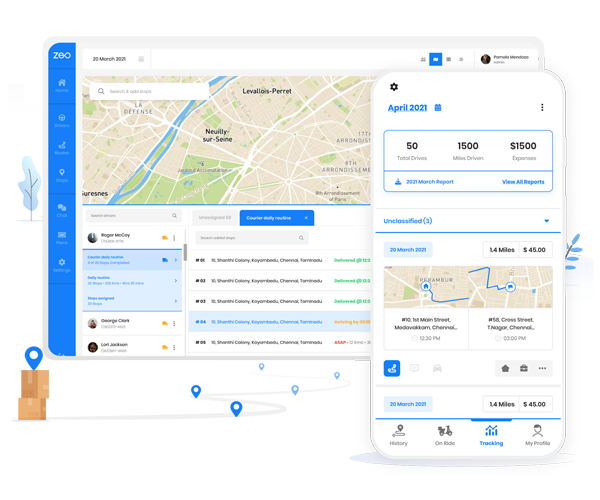Today’s businesses constantly strive to increase the efficiency and reliability of delivery processes — which is crucial for meeting customer expectations and maintaining a competitive edge.
The retail delivery process encompasses various stages, from managing inventory to packaging and shipping items to customers. In this blog post, we will explore the concept of retail delivery, the challenges faced by businesses, and how advanced retail delivery software, such as Zeo Route Planner, can help overcome these challenges.
What is Retail Delivery?
Retail delivery refers to the process of transporting products from a retail distribution center or store to the end consumer. It is a vital aspect of the customer experience, as it determines the speed and quality of product delivery. Retailers strive to optimize their delivery processes to ensure timely and accurate shipments while minimizing costs.
What is a Retail Delivery Software?
A retail delivery software is a technological solution that streamlines and automates various aspects of the delivery process. It provides tools for order management, order tracking, route planning, and more. Such software solutions enable retailers to enhance operational efficiency, reduce costs, and improve customer satisfaction.
How Does Retail Delivery Work?
The retail delivery process involves several interconnected steps that ensure the smooth movement of products from the warehouse to the customer’s doorstep. Let’s take a closer look at each of these stages:
- Inventory Management: Efficient inventory management is crucial for successful retail delivery. Retailers must keep track of stock levels, monitor product availability, and forecast demand accurately. Efficient inventory management helps regulate stock levels and facilitates seamless order fulfillment.
- Inventory Warehousing: Retailers often maintain large warehouses to store their inventory. These warehouses should be strategically located to ensure optimal proximity to the target markets. Proper inventory warehousing optimizes the allocation of products within the facility and minimizes unnecessary movements.
- Receiving: When new inventory arrives at the warehouse, it needs to be properly received and documented. Doing so ensures accurate inventory tracking and management.
- Packaging: Once an order is placed, the warehouse staff starts the packaging process, preparing various items per the guidelines and preparing them for shipment.
- Shipping: Shipping is a critical phase in the retail delivery process. Retail delivery software offers route optimization, driver selection, and tracking integration features. It helps identify the most efficient routes, select reliable drivers, and provide customers with real-time updates on the status of their shipments.
- Returns: Handling returns is an essential part of the retail delivery process. Here too, retail delivery software comes in handy with systematic returns processing.
Read more: Top 5 Best Practices for Retail Deliveries in 2023.
What are the Biggest Challenges Faced by Retail Delivery Businesses?
Despite the significance of the retail delivery process, businesses encounter various challenges that can hinder their efficiency and profitability. Let’s explore some of the major hurdles faced by retail delivery businesses:

increase fuel savings
Hassle Free Deliveries & Pickups!
Optimize routes with our algorithm, reducing travel time and costs efficiently.
Get Started for Free
- Growing Delivery Costs: Rising fuel prices, labor expenses, and increasing customer expectations escalate delivery costs. Retailers must optimize their routes and minimize travel distances to mitigate these expenses.
- Shipping Unpredictability: Shipping operations can be affected by unforeseen events such as traffic congestion, weather conditions, or vehicle breakdowns. These unpredictable factors can lead to delays and impact customer satisfaction.
- Unnecessary Delays: Inefficient route planning and inadequate communication can result in unnecessary delays during delivery. Delays can frustrate customers, damage the retailer’s reputation, and lead to missed business opportunities.
Read more: The Role of Delivery Partnerships in Retail: Expanding Reach and Enhancing Delivery Options.
How Can a Retail Delivery Software like Zeo Help You?
Leveraging a retail delivery tool like Zeo can help you successfully implement a smooth and efficient delivery process. Some of its primary benefits are:
- Smart Route Planning: Zeo Route Planner, an advanced retail delivery software, utilizes cutting-edge algorithms to optimize delivery routes. It considers multiple factors like traffic conditions, vehicle capacity, and delivery windows to create the most efficient routes. As a retailer, you can reduce fuel costs and enhance overall delivery efficiency by minimizing travel distances and time.
- Reduced Delivery Time: Efficient route planning and real-time tracking provided by Zeo enable retailers to deliver products promptly. The software helps you meet customer expectations and increase customer satisfaction by optimizing routes and providing accurate estimated arrival times.
- Enhanced Profitability: By reducing delivery costs and enhancing operational efficiency, retail delivery software like Zeo significantly contributes to the overall profitability of your business. Improved route optimization and reduced delays result in cost savings and higher productivity, ultimately boosting the bottom line.
End Note
An efficient and streamlined delivery process is crucial for success in the increasingly competitive retail industry. Retail delivery software, such as Zeo Route Planner, empowers businesses to overcome the challenges of order management, route planning, and delivery execution.
By leveraging such advanced technologies and automation, you can optimize your operations, reduce costs, and enhance customer satisfaction. Embracing retail delivery software is a strategic decision that can help you stay ahead in the ever-evolving retail landscape.
Eager to learn more about Zeo? Book a free demo today!

Are you a fleet owner?
Want to manage your drivers and deliveries easily?
Grow your business effortlessly with Zeo Routes Planner – optimize routes and manage multiple drivers with ease.

increase fuel savings
Hassle Free Deliveries & Pickups!
Optimize routes with our algorithm, reducing travel time and costs efficiently.
Get Started for Free




















